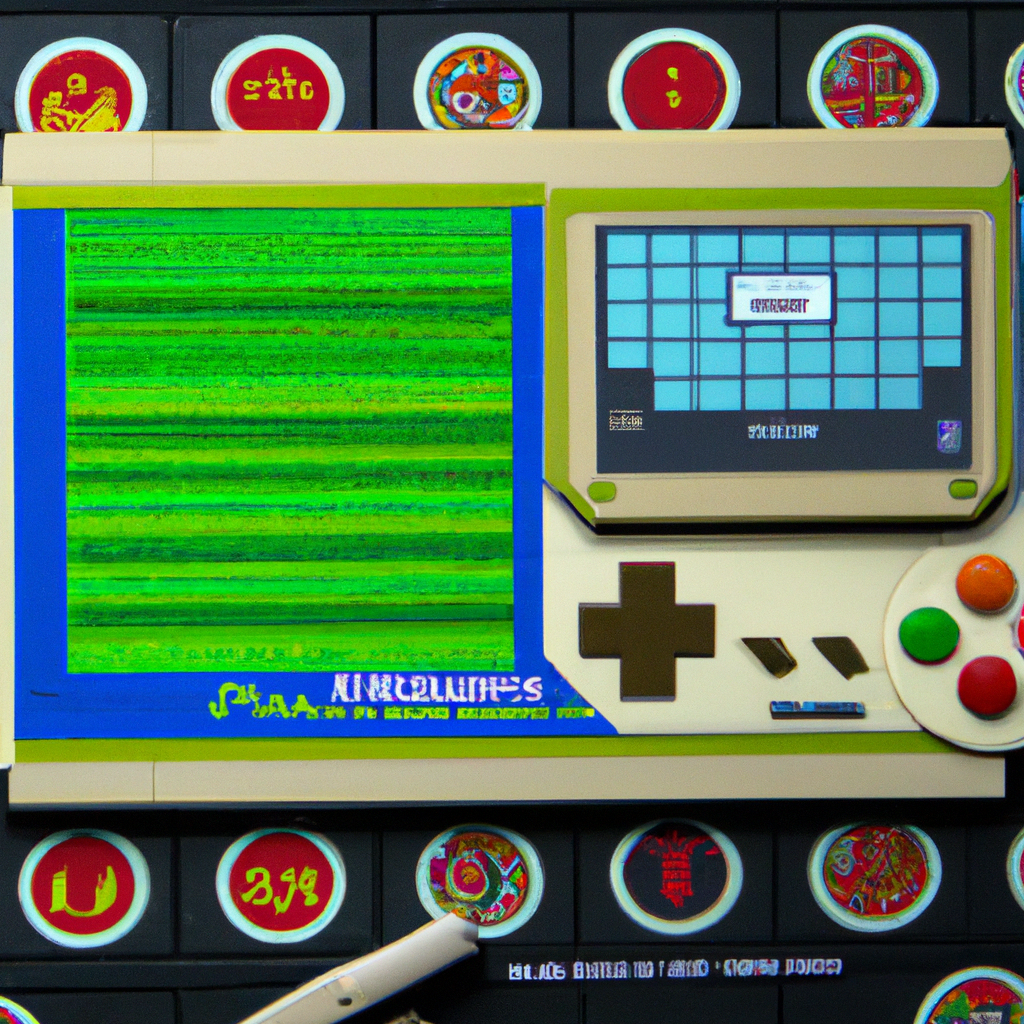Journey with us as we embark on an extraordinary quest through the fantastical realms of gaming history. From the humble beginnings of pixelated adventures in the 8-bit era to the mind-bending virtual reality experiences of today, the evolution of the gaming industry has been nothing short of awe-inspiring. Strap on your virtual helmets and prepare to unlock the secrets behind the mesmerizing worlds that have captured our imaginations for decades. Welcome to a captivating odyssey, where the boundaries between reality and gaming bliss seamlessly intertwine, as we explore the rich tapestry of gaming worlds and the incredible ingenuity that has shaped them.
From Pixels to Reality: The Pioneering Era of 8-Bit Gaming
Step into a time when gaming was simpler yet enthralling, a time when immersive virtual worlds were brought to life by mere 8 bits. In the pioneering era of 8-bit gaming, creativity, imagination, and a dash of technical wizardry merged to redefine entertainment forever. This nostalgic epoch marked a transformative shift that laid the foundation for the innovative gaming industry we know today.
Through the flickering screens of home consoles and arcade cabinets, a new era of pixelated wonder was born. Let your mind wander back to a time when heroes wore blocky capes and princesses were but a few pixels high. These games captivated millions, leaving an indelible mark on the hearts and minds of gamers around the globe. From iconic characters like Mario, Link, and Mega Man to groundbreaking franchises like Space Invaders and Pac-Man, the 8-bit pioneers paved the way for the limitless possibilities of modern gaming.

The Dawn of Immersive Experiences: Exploring the Transition to 3D Gaming
Immersive experiences have taken the world of gaming by storm, paving the way for a new era of three-dimensional entertainment like never before. The transition to 3D gaming has redefined the way we interact with virtual worlds, allowing players to dive headfirst into a realm where reality and fantasy converge.
One of the most captivating aspects of this transition is the unprecedented level of visual realism that can be achieved. The meticulously designed 3D landscapes bring virtual worlds to life, immersing players in breathtaking environments that were once limited to their imagination. From sprawling, dynamic cities to lush, vibrant forests, the attention to detail is awe-inspiring. The subtle play of light and shadow, the intricate textures, and the lifelike animations combine to create an unparalleled sense of presence, making players truly feel like they are part of the game.
Unleashing Unimaginable Possibilities
With the dawn of immersive experiences, the transition to 3D gaming has not only redefined visuals, but also gameplay itself. Developers now have the opportunity to craft gameplay mechanics that fully utilize the three-dimensional space, opening an abundance of possibilities for creative game design. Maneuvering through complex mazes, scaling towering cliffs, or engaging in intense aerial battles are just a few examples of the thrilling experiences that await gamers.
- Seamless Integration: The seamless integration of interactive objects within the game world enhances player immersion.
- Spatial Awareness: Players can now rely on their spatial awareness in three dimensions, introducing new challenges and puzzles.
- Depth of Exploration: The move to 3D gaming enables vast, open worlds to be explored in unprecedented detail, enticing players to discover hidden secrets and engage with captivating narratives.
Revolutionizing the Gaming Landscape: Embracing Virtual Reality Technology
Gamers around the world are witnessing a monumental shift in the way they experience their favorite pastime, thanks to the rapid growth of virtual reality (VR) technology. The gaming industry has always strived to provide immersive and captivating experiences, and VR is opening up a whole new world of possibilities. With its ability to transport players into incredibly realistic and interactive virtual environments, VR technology is revolutionizing the way games are played, pushing the boundaries of what we once thought was possible.
One of the most intriguing aspects of VR gaming is the way it engulfs all of your senses, creating a truly multi-dimensional experience. By strapping on a VR headset and equipping the accompanying controllers, gamers can step into a virtual realm that feels incredibly real. The level of immersion is unparalleled, as you find yourself directly in the heart of the action. With vivid visuals, precise motion tracking, and spatial soundscapes, every move you make, every sound you hear, becomes an integral part of the gameplay. It blurs the line between the physical and virtual world, as you interact with the game environment using your own body and natural gestures.
- Virtual reality technology transports players into hyper-realistic and interactive virtual environments.
- VR gaming creates a true multi-dimensional experience, stimulating all of your senses.
- Immersive visuals, precise motion tracking, and spatial soundscapes enhance gameplay.
- Interacting with the game environment using natural gestures creates an unparalleled level of engagement.
Beyond Entertainment: The Potential of Gaming Worlds in Education and Training
In today’s fast-paced and technology-driven world, traditional methods of education and training are constantly evolving to keep up with the demands of an ever-changing job market. One surprising avenue for learning that has gained immense popularity is gaming worlds. These virtual environments offer a unique and engaging platform that goes beyond mere entertainment, presenting vast potential in the realm of education and training.
Unleashing the potential of gaming worlds in education opens up a whole new world of possibilities. Here are a few ways gaming worlds can enhance learning and training experiences:
- Immersive Learning: Imagine stepping into historical events or exploring complex scientific concepts through interactive simulations. Gaming worlds provide a level of immersion that traditional textbooks simply cannot match.
- Collaborative Problem Solving: In multiplayer games, teamwork and cooperation are essential for success. Utilizing gaming worlds allows learners to collaborate and solve problems together, fostering critical thinking, communication, and leadership skills.
- Real-Time Skill Development: Gaming worlds provide a safe space for learners to practice and refine various skills in real-time. Whether it’s simulating medical procedures or mastering complex coding languages, learners can gain practical experience without real-world consequences.
In Summary
As we conclude our journey through the captivating history of gaming worlds, we find ourselves marveling at the incredible evolution that has taken place in the gaming industry. From the humble beginnings of 8-bit graphics to the mind-bending virtual reality experiences of today, gamers have embarked on a transformative adventure of their own.
Looking back, it is awe-inspiring to witness how gaming has flourished from a simple form of entertainment into a cultural phenomenon. With every passing year, developers have pushed the boundaries of technology, harnessing the power of innovation to create breathtaking virtual realms. These worlds became not just pixelated playgrounds, but portals to unimaginable dimensions that captured the hearts and minds of millions.
The impact of gaming on society cannot be overstated. With each passing generation, gaming has carved out a unique space in our lives, becoming more than just a pastime. It has become a conduit for friendships, a source of inspiration, and a platform for self-expression. Gaming worlds have nurtured creativity, fostering legions of aspiring artists, musicians, and storytellers who have found their voice within these digital landscapes.
From the nostalgic days of arcade cabinets to the revolutionary consoles that brought gaming into our living rooms, the trailblazers of the industry have left an indelible mark on our collective consciousness. Each era brings with it its own defining moments, from the advent of online multiplayer to the seamless integration of virtual reality. These milestones not only transformed gaming technology but also redefined the way we perceive and interact with virtual spaces.
As we stand on the precipice of yet another revolution in gaming, with virtual reality breaking down the barriers between the real and the digital, it is impossible not to acknowledge the tireless passion and unyielding dedication of gamers and game developers alike. Their unwavering commitment to creating ever more immersive and engaging experiences has propelled the industry to new and unimaginable heights.
So here we conclude our exploration of the history of gaming worlds, a journey filled with nostalgia, innovation, and wonder. As we bid farewell to the neon-lit arcades and enter the realm of virtual reality, it is with excitement and anticipation that we await the next chapter in this ever-evolving adventure. Let us remember that gaming, at its core, is a testament to the human spirit, an enduring testament to our hunger for exploration and our insatiable desire to escape into worlds beyond our wildest dreams.
From the heyday of arcades and 8-bit consoles to the dawn of virtual reality, the gaming industry has seen its fair share of ups and downs. With the invention of the first game console in the late 1950s, gaming slowly grew into a multi-billion-dollar industry. So, what has made gaming so enduringly popular? What has driven the evolution of the gaming industry?
One of the reasons why gaming has had such enduring appeal is its diversity. From interactive sports games to complex role-playing games, there’s a type of game for every type of person. And with the constant emergence of new technologies, gaming worlds are becoming increasingly immersive and imaginative. Today, we can hop into the driver’s seat of a virtual car or role-play a knight in a simulated medieval world – marvels that were once unthinkable. By creating more immersive gaming universes, developers have been able to capture a broader audience, inspiring a sense of awe among older and newer generations alike.
The development of graphics has played an essential role in the evolution of gaming worlds. The days of the 8-bit gaming consoles are long gone, with the industry moving onto an entirely new era of 3D graphics. This means that we can now experience gaming with the same level of realism as in a movie theatre or theme park. Alongside graphics, the rapid advancement of artificial intelligence has made gaming more dynamic and interactive than ever before. AI can now simulate conversations and give lifelike responses based on the player’s actions. For instance, the character might say something different if the player attacks a monster, or chooses a more peaceful approach.
Last but not least, we must not forget the impact of virtual reality on the gaming industry. As game developers create more realistic and immersive gaming universes, the lines between virtual and real worlds have become blurred. Through the use of virtual reality headsets, players are able to immerse themselves in a completely new gaming sandbox. With the push of a button, gamers can teleport themselves into a painted desert sky or venture into a mysterious alien world, providing a sense of freedom and exploration unimaginable in traditional gaming.
It’s truly remarkable how far gaming has come in the last few decades. With the advancement of graphics, AI and virtual reality, the gaming industry is transforming into an immersive and lifelike form of entertainment. It is surely interesting, and exciting, to see where gaming will go in the years to come.



